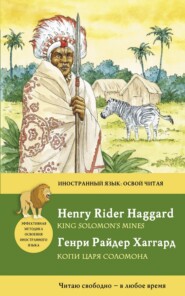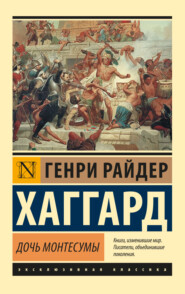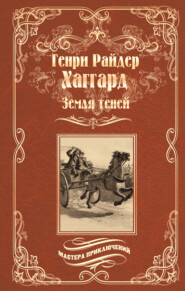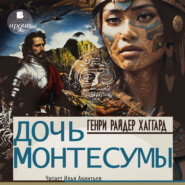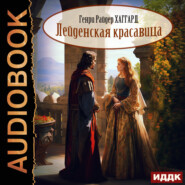По всем вопросам обращайтесь на: info@litportal.ru
(©) 2003-2024.
✖
She: A History of Adventure
Автор
Серия
Год написания книги
1887
Настройки чтения
Размер шрифта
Высота строк
Поля
HOC FECIT
DOROTHEA VINCEY.
Perfectly bewildered, I turned the relic over. It was covered from top to bottom with notes and signatures in Greek, Latin, and English. The first in uncial Greek was by Tisisthenes, the son to whom the writing was addressed. It was, “I could not go. Tisisthenes to his son, Kallikrates.” Here it is in fac-simile with its cursive equivalent: – ΟΥΚΑΝΔΥΝΑΙΜΗΝΠΟΡΕΥΕСΘΑΙΤΙСΙСΘΕΝΗС
ΚΑΛΛΙΚΡΑΤΕΙΤΩΙΠΑΙΔΙ
οὐκ ἂν δυναίμην πορεύεσθαι. Τισισθένης Καλλικράτει τῷ παιδί.
This Kallikrates (probably, in the Greek fashion, so named after his grandfather) evidently made some attempt to start on the quest, for his entry written in very faint and almost illegible uncial is, “I ceased from my going, the gods being against me. Kallikrates to his son.” Here it is also: –
ΤΩΝΘΕΩΝΑΝΤΙΣΤΑΝΤΩΝΕΠΑΥΣΑΜΗΝΤΗΣΠΟΡΕΙΑΣΑΛΛΙΚΡΑΤΗΣΤΩΙΠΑΙΔΙ
τῶν θεῶν ἀντιστάντων ἐπαυσάμην τῆς πορείας. Καλλικράτης τῷ παιδί.
Between these two ancient writings, the second of which was inscribed upside down and was so faint and worn that, had it not been for the transcript of it executed by Vincey, I should scarcely have been able to read it, since, owing to its having been written on that portion of the tile which had, in the course of ages, undergone the most handling, it was nearly rubbed out – was the bold, modern-looking signature of one Lionel Vincey, “Ætate sua 17,” which was written thereon, I think, by Leo’s grandfather. To the right of this were the initials “J. B. V.,” and below came a variety of Greek signatures, in uncial and cursive character, and what appeared to be some carelessly executed repetitions of the sentence τῷ παιδί (to my son), showing that the relic was religiously passed on from generation to generation.
The next legible thing after the Greek signatures was the word “Romae, A.U.C.,” showing that the family had now migrated to Rome. Unfortunately, however, with the exception of its termination (evi) the date of their settlement there is for ever lost, for just where it had been placed a piece of the potsherd is broken away.
Then followed twelve Latin signatures, jotted about here and there, wherever there was a space upon the tile suitable to their inscription. These signatures, with three exceptions only, ended with the name “Vindex” or “the Avenger,” which seems to have been adopted by the family after its migration to Rome as a kind of equivalent to the Greek “Tisisthenes,” which also means an avenger. Ultimately, as might be expected, this Latin cognomen of Vindex was transformed first into De Vincey, and then into the plain, modern Vincey. It is very curious to observe how the idea of revenge, inspired by an Egyptian who lived before the time of Christ, is thus, as it were, embalmed in an English family name.
A few of the Roman names inscribed upon the sherd I have actually since found mentioned in history and other records. They were, if I remember right,
MVSSIVS. VINDEX
SEX. VARIVS MARVLLVS
C. FVFIDIVS. C. F. VINDEX
and
LABERIA POMPEIANA. CONIVX. MACRINI. VINDICIS
this last being, of course, the name of a Roman lady.
The following list, however, comprises all the Latin names upon the sherd: –
C. CAECILIVS VINDEX
M. AIMILIVS VINDEX
SEX. VARIVS. MARVLLVS
Q. SOSIVS PRISCVS SENECIO VINDEX
L. VALERIVS COMINIVS VINDEX
SEX. OTACILIVS. M. F.
L. ATTIVS. VINDEX
MVSSIVS VINDEX
C. FVFIDIVS. C. F. VINDEX
LICINIVS FAVSTVS
LABERIA POMPEIANA CONIVX MACRINI VINDICIS
MANILIA LVCILLA CONIVX MARVLLI VINDICIS
After the Roman names there is evidently a gap of very many centuries. Nobody will ever know now what was the history of the relic during those dark ages, or how it came to have been preserved in the family. My poor friend Vincey had, it will be remembered, told me that his Roman ancestors finally settled in Lombardy, and when Charlemagne invaded it, returned with him across the Alps, and made their home in Brittany, whence they crossed to England in the reign of Edward the Confessor. How he knew this I am not aware, for there is no reference to Lombardy or Charlemagne upon the tile, though, as will presently be seen, there is a reference to Brittany. To continue: the next entries on the sherd, if I may except a long splash either of blood or red colouring matter of some sort, consist of two crosses drawn in red pigment, and probably representing Crusaders’ swords, and a rather neat monogram (“D. V.”) in scarlet and blue, perhaps executed by that same Dorothea Vincey who wrote, or rather painted, the doggrel couplet. To the left of this, inscribed in faint blue, were the initials A. V., and after them a date, 1800.
Then came what was perhaps as curious an entry as anything upon this extraordinary relic of the past. It is executed in black letter, written over the crosses or Crusaders’ swords, and dated fourteen hundred and forty-five. As the best plan will be to allow it to speak for itself, I here give the black-letter fac-simile, together with the original Latin without the contractions, from which it will be seen that the writer was a fair mediaeval Latinist. Also we discovered what is still more curious, an English version of the black-letter Latin. This, also written in black letter, we found inscribed on a second parchment that was in the coffer, apparently somewhat older in date than that on which was inscribed the mediaeval Latin translation of the uncial Greek of which I shall speak presently. This I also give in full.
Fac-simile of Black-Letter Inscription on the Sherd of Amenartas.
Expanded Version of the above Black-Letter Inscription
“Ista reliquia est valde misticum et myrificum opus, quod majores mei ex Armorica, scilicet Britannia Minore, secum convehebant; et et quidam sanctus clericus semper patri meo in manu ferebat quod penitus illud destrueret, affirmans quod esset ab ipso Sathana conflatum prestigiosa et dyabolica arte, quare pater meus confregit illud in duas partes, quas quidem ego Johannes de Vinceto salvas servavi et adaptavi sicut appa-ret die lune proximo post festum beate Marie Virginis anni gratie MCCCCXLV.”
Fac-simile of the Old English Black-Letter Translation of the above Latin Inscription from the Sherd of Amenartas found inscribed upon a parchment.
Modernised Version of the above Black-Letter Translation
“Thys rellike ys a ryghte mistycall worke and a marvaylous, ye whyche myne aunceteres aforetyme dyd conveigh hider with them from Armoryke which ys to seien Britaine ye Lesse and a certayne holye clerke should allweyes beare my fadir on honde that he owghte uttirly for to frusshe ye same, affyr-mynge that yt was fourmed and conflatyed of Sathanas hym selfe by arte magike and dyvellysshe wherefore my fadir dyd take ye same and tobrast yt yn tweyne, but I, John de Vincey, dyd save whool ye tweye partes therof and topeecyd them to-gydder agayne soe as yee se, on this daye mondaye next fol-lowynge after ye feeste of Seynte Marye ye Blessed Vyrgyne yn ye yeere of Salvacioun fowertene hundreth and fyve and fowerti.”
The next and, save one, last entry was Elizabethan, and dated 1564. “A most strange historie, and one that did cost my father his life; for in seekynge for the place upon the east coast of Africa, his pinnance was sunk by a Portuguese galleon off Lorenzo Marquez, and he himself perished. – John Vincey.”
Then came the last entry, apparently, to judge by the style of writing, made by some representative of the family in the middle of the eighteenth century. It was a misquotation of the well-known lines in Hamlet, and ran thus: “There are more things in Heaven and earth than are dreamt of in your philosophy, Horatio.”
And now there remained but one more document to be examined – namely, the ancient black-letter transcription into mediaeval Latin of the uncial inscription on the sherd. As will be seen, this translation was executed and subscribed in the year 1495, by a certain “learned man,” Edmundus de Prato (Edmund Pratt) by name, licentiate in Canon Law, of Exeter College, Oxford, who had actually been a pupil of Grocyn, the first scholar who taught Greek in England. No doubt, on the fame of this new learning reaching his ears, the Vincey of the day, perhaps that same John de Vincey who years before had saved the relic from destruction and made the black-letter entry on the sherd in 1445, hurried off to Oxford to see if perchance it might avail to dissolve the secret of the mysterious inscription. Nor was he disappointed, for the learned Edmundus was equal to the task. Indeed his rendering is so excellent an example of mediaeval learning and latinity that, even at the risk of sating the learned reader with too many antiquities, I have made up my mind to give it in fac-simile, together with an expanded version for the benefit of those who find the contractions troublesome. The translation has several peculiarities on which this is not the place to dwell, but I would in passing call the attention of scholars to the passage “duxerunt autem nos ad reginam advenaslasanis-coronantium,” which strikes me as a delightful rendering of the original, “ἤγαγον δὲ ὡς βασίλειαν τὴν τῶν ξένους χύτραις στεφανούντων.”
mediaeval Black-Letter Latin Translation of the Uncial Inscription on the Sherd of Amenartas
Expanded Version of the above Mediaeval Latin Translation
Amenartas, e genere regio Egyptii, uxor Callicratis, sac-erdotis Isidis, quam dei fovent demonia attendunt, filiolo suo Tisistheni jam moribunda ita mandat: Effugi quodam ex Egypto, regnante Nectanebo, cum patre tuo, propter mei amorem pejerato. Fugientes autem versus Notum trans mare, et viginti quatuor menses per litora Libye versus Ori-entem errantes, ubi est petra quedam magna sculpta instar Ethiopis capitis, deinde dies quatuor ab ostio fluminis magni ejecti partim submersi sumus partim morbo mortui sumus: in fine autem a feris hominibus portabamur per paludes et vada, ubi avium multitudo celum obumbrat, dies decem, donec advenimus ad cavum quendam montem, ubi olim magna urbs erat, caverne quoque immense; duxerunt autem nos ad reginam Advenaslasaniscoronantium, que magicâ utebatur et peritiá omnium rerum, et saltem pul-critudine et vigore insenescibilis erat. Hec magno patris tui amore perculsa, primum quidem ei connubium michi mortem parabat; postea vero, recusante Callicrate, amore mei et timore regine affecto, nos per magicam abduxit per vias horribiles ubi est puteus ille profundus, cujus juxta aditum jacebat senioris philosophi cadaver, et advenientibus mons-travit flammam Vite erectam, instar columne voluntantis, voces emittentem quasi tonitrus: tunc per ignem impetu nocivo expers transiit et jam ipsa sese formosior visa est.
Quibus factis juravit se patrem tuum quoque immor-talem ostensuram esse, si me prius occisa regine contuber-nium mallet; neque enim ipsa me occidere valuit, propter nostratum magicam cujus egomet partem habeo. Ille vero nichil hujus generis malebat, manibus ante oculos passis, ne mulieris formositatem adspiceret: postea illum magica percussit arte, at mortuum efferebat inde cum fletibus et vagitibus, et me per timorem expulit ad ostium magni flu-minis, velivoli, porro in nave, in qua te peperi, vix post dies huc Athenas vecta sum. At tu, O Tisisthenes, ne quid quorum mando nauci fac: necesse enim est mulierem exquirere si qua Vite mysterium impetres et vindicare, quautum in te est, patrem tuum Callieratem in regine morte. Sin timore sue aliqua causa rem reliquis infectam, hoc ipsum omnibus posteris mando, dum bonus quis inveniatur qui ignis lavacrum non perhorrescet, et potentia dignus dominabitur hominum.
Talia dico incredibilia quidem at minime ficta de rebus michi cognitis.
Hec Grece scripta Latine reddidit vir doctus Edmun-dus de Prato, in Descretis Licenciatus, e Collegio Exoniensi Oxoniensi doctissimi Grocyni quondam e pupillis, Idibus Aprilis Anno Domini MCCCCLXXXXV°.
“Well,” I said, when at length I had read out and carefully examined these writings and paragraphs, at least those of them that were still easily legible, “that is the conclusion of the whole matter, Leo, and now you can form your own opinion on it. I have already formed mine.”
“And what is it?” he asked, in his quick way.






